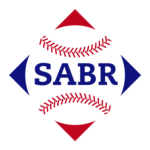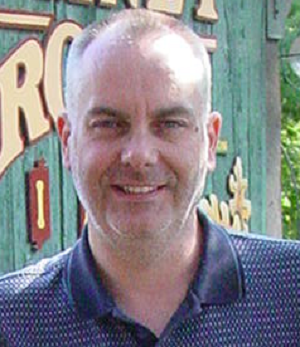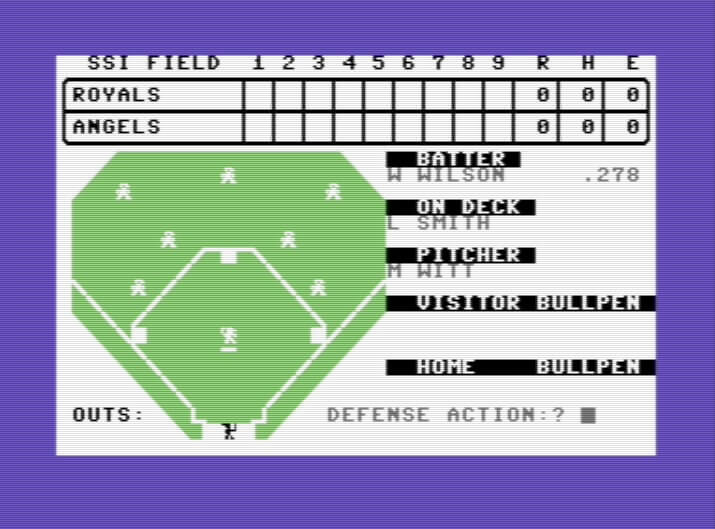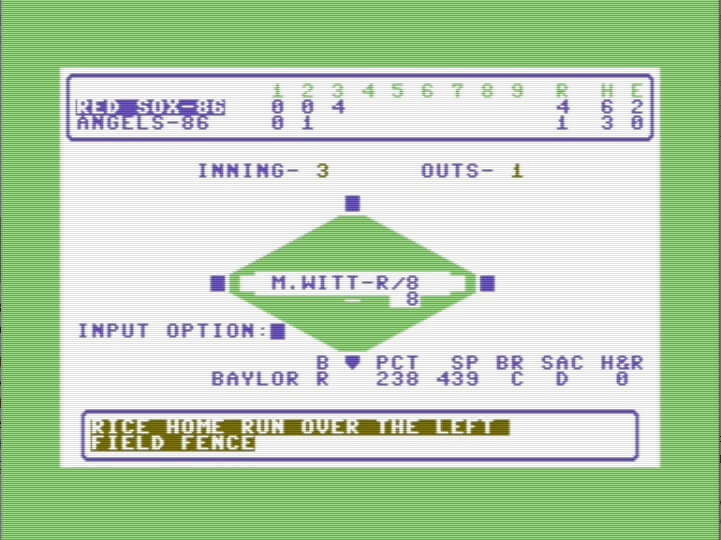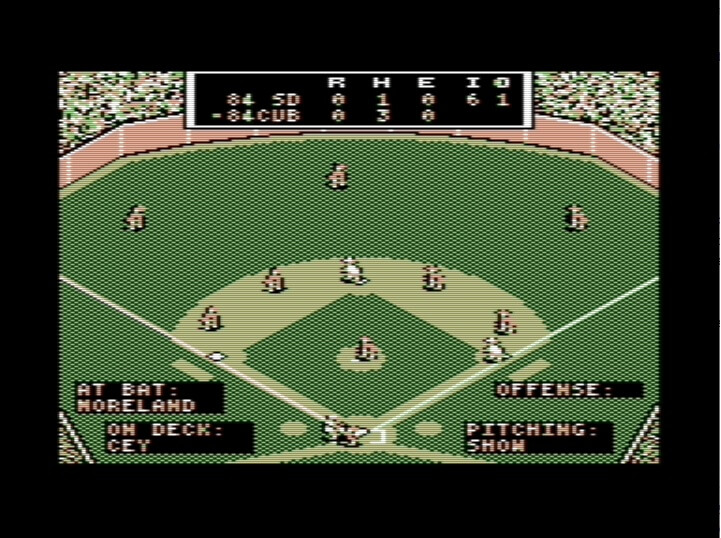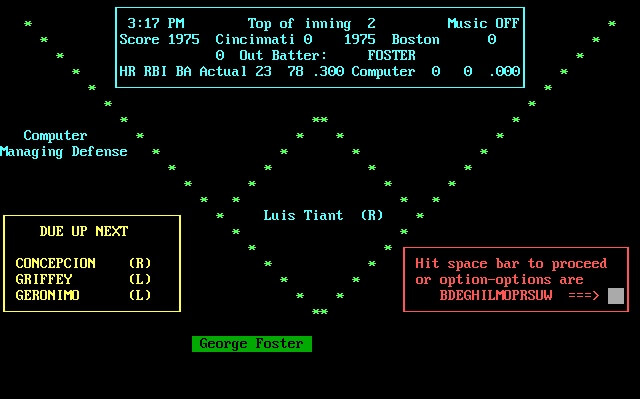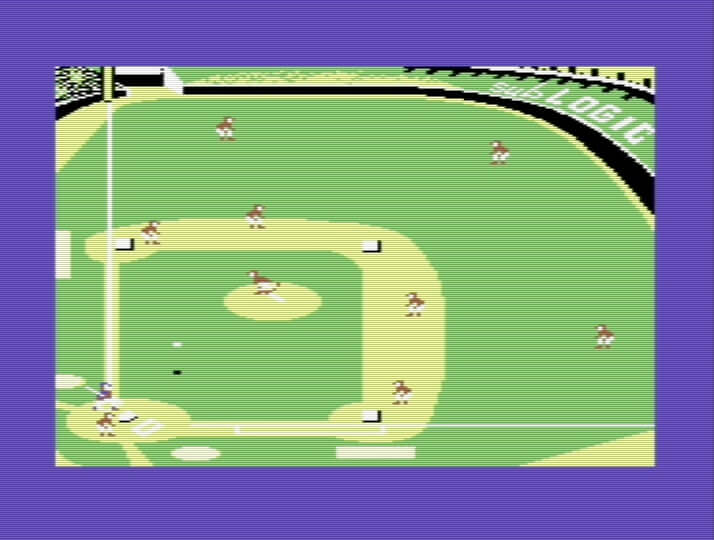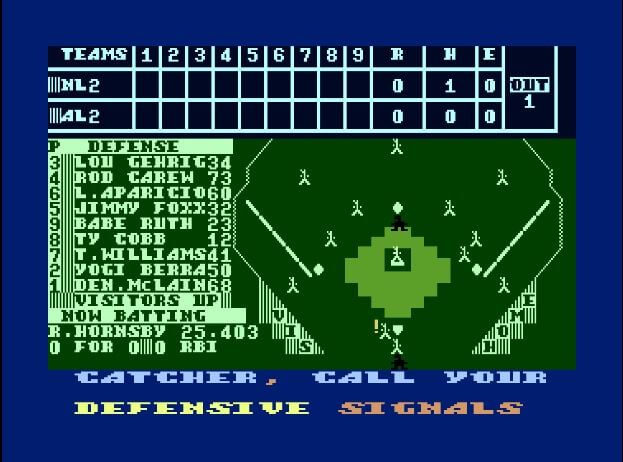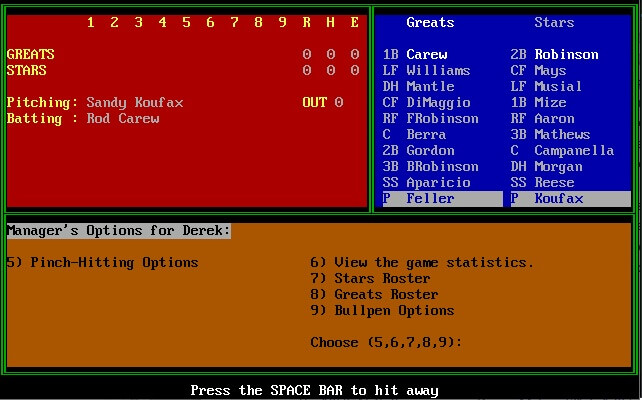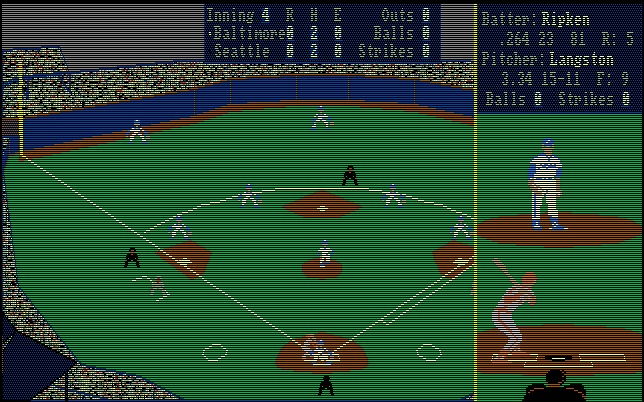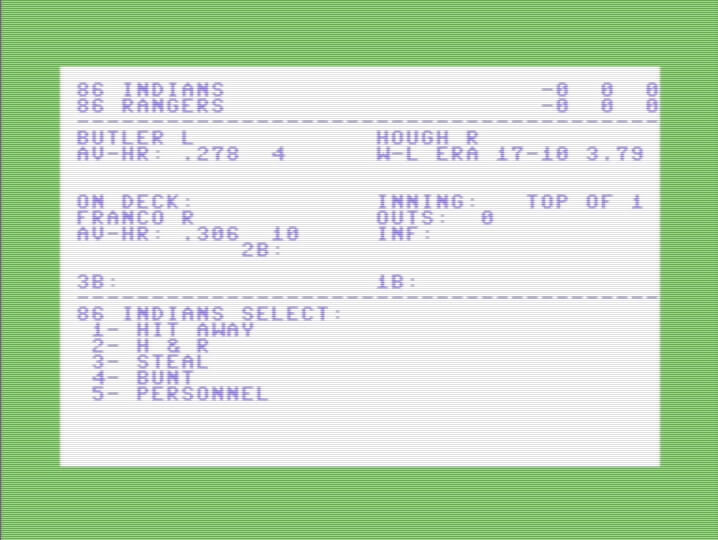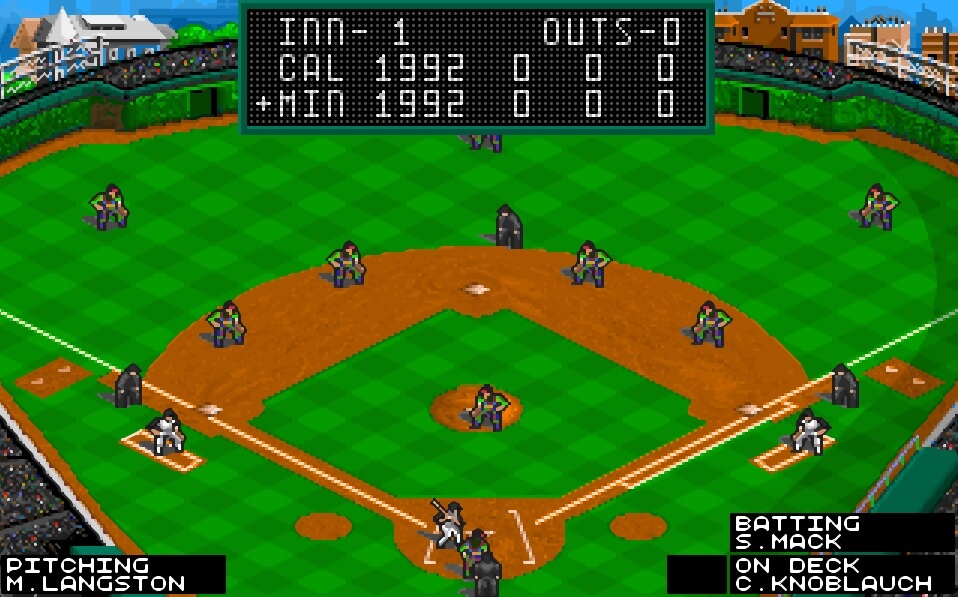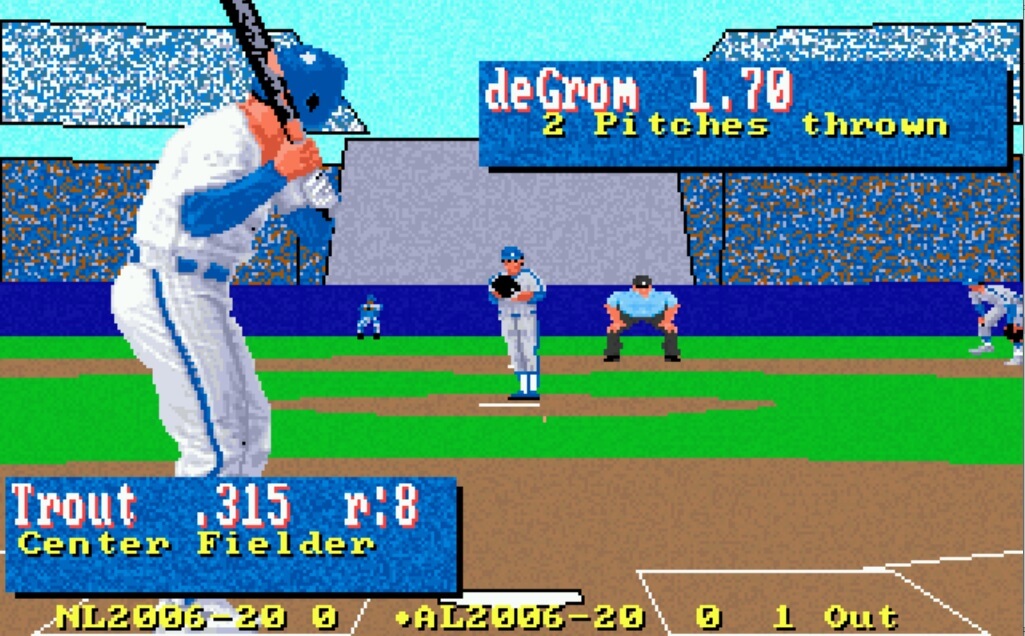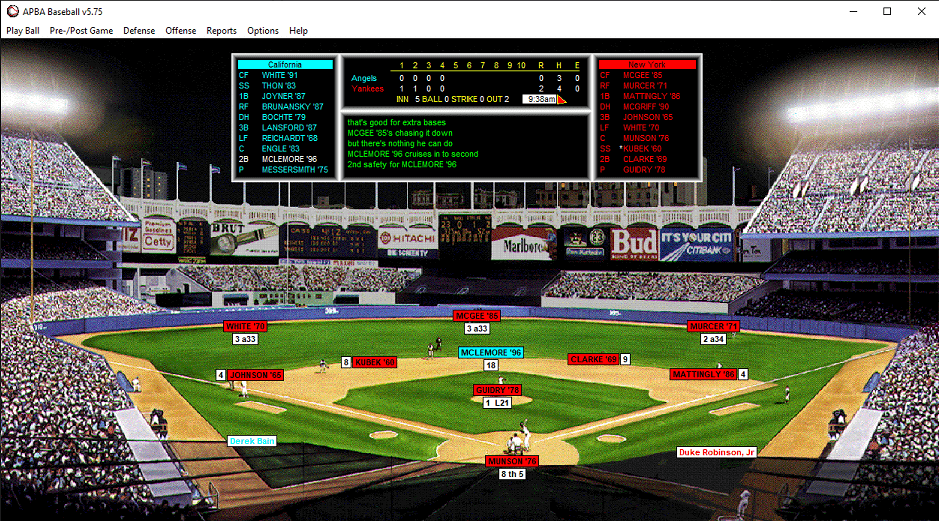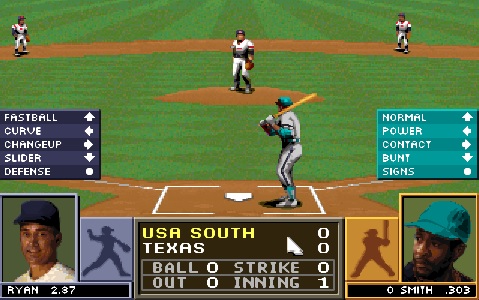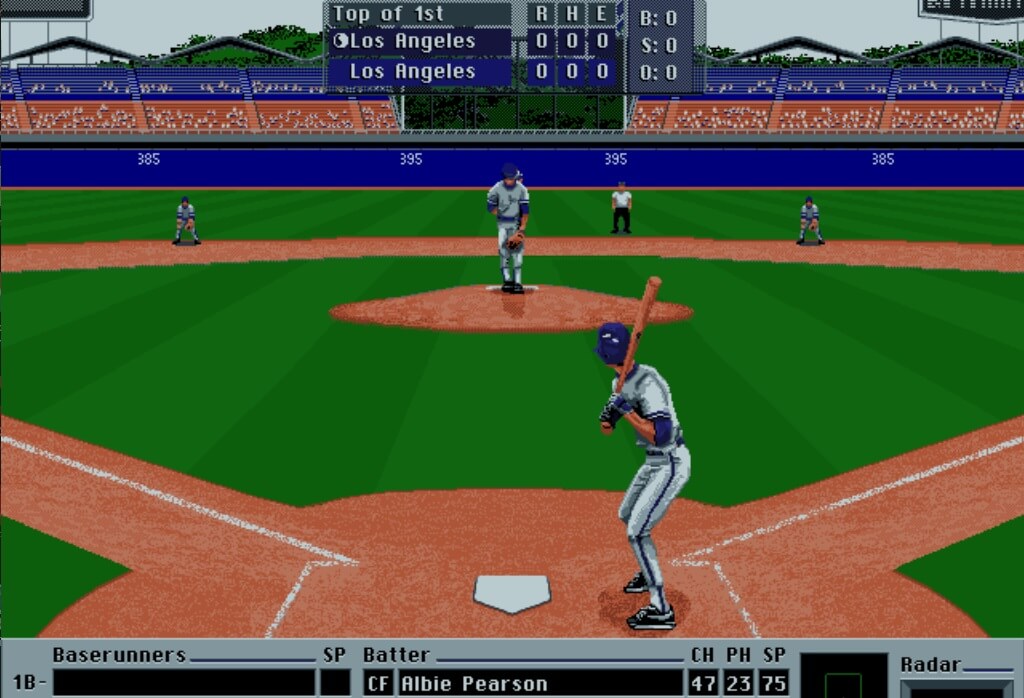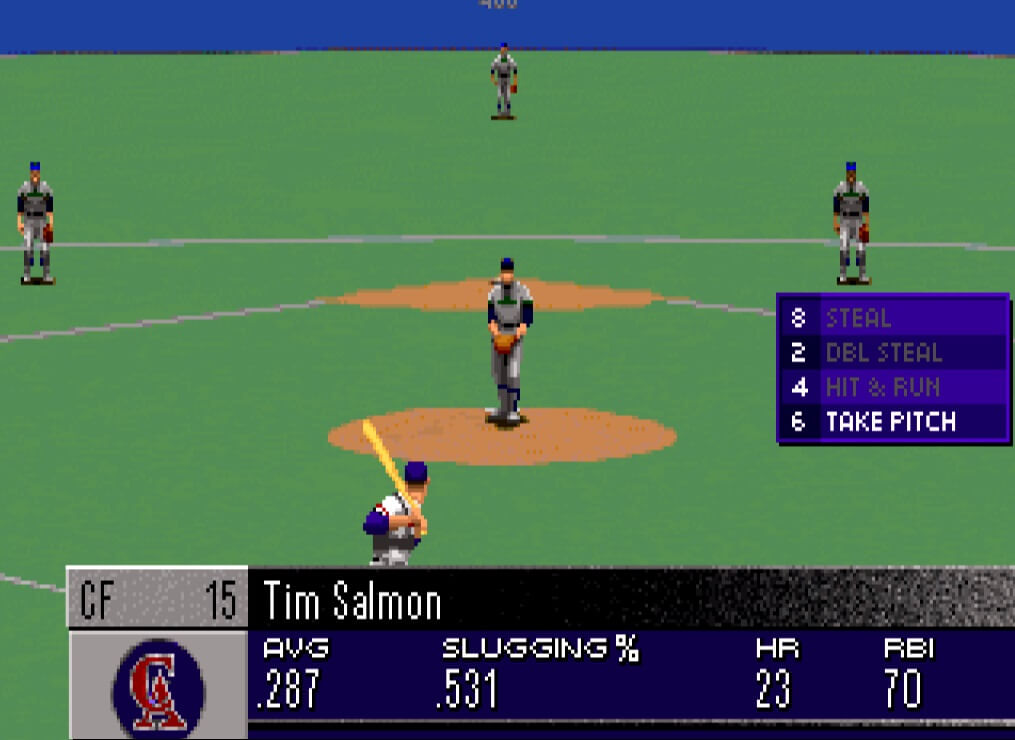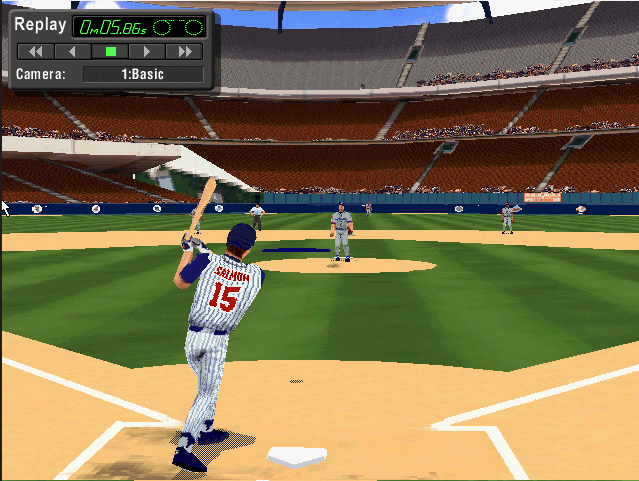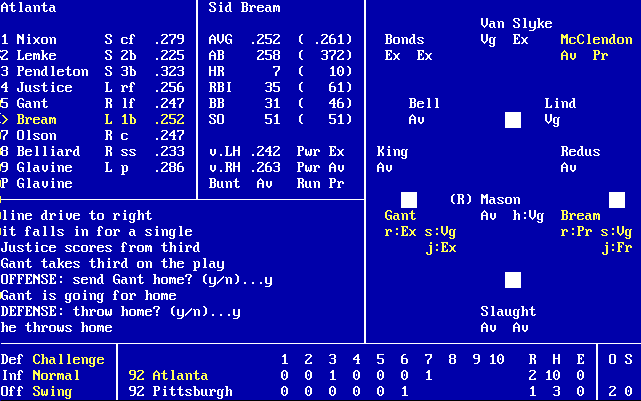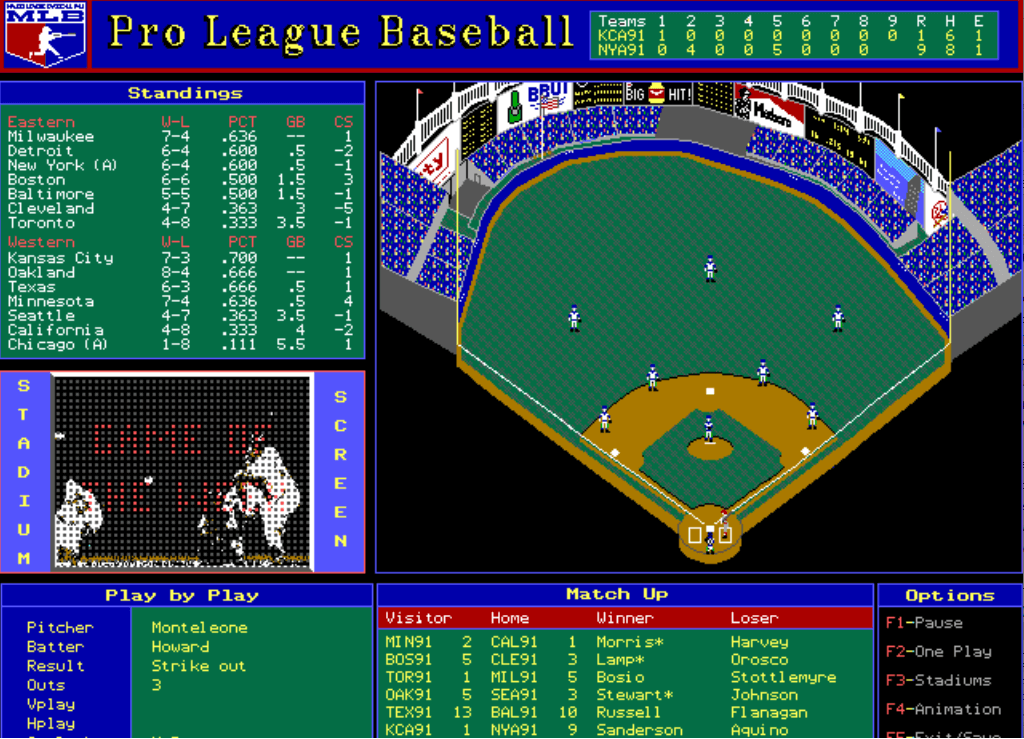This is the eleventh entry in a series focusing on computer baseball simulations to supplement the chapter “Play Retro Baseball Video Games In Your Browser” from my Hardball Retroactive book along with the corresponding post at Hardball Retro. The series focuses on baseball simulations – games in which the primary emphasis is on managerial strategy and the ability to replay entire seasons with a degree of realism. Baseball video games that are strictly arcade representations of baseball (based solely on reflex and hand-eye coordination) are excluded.
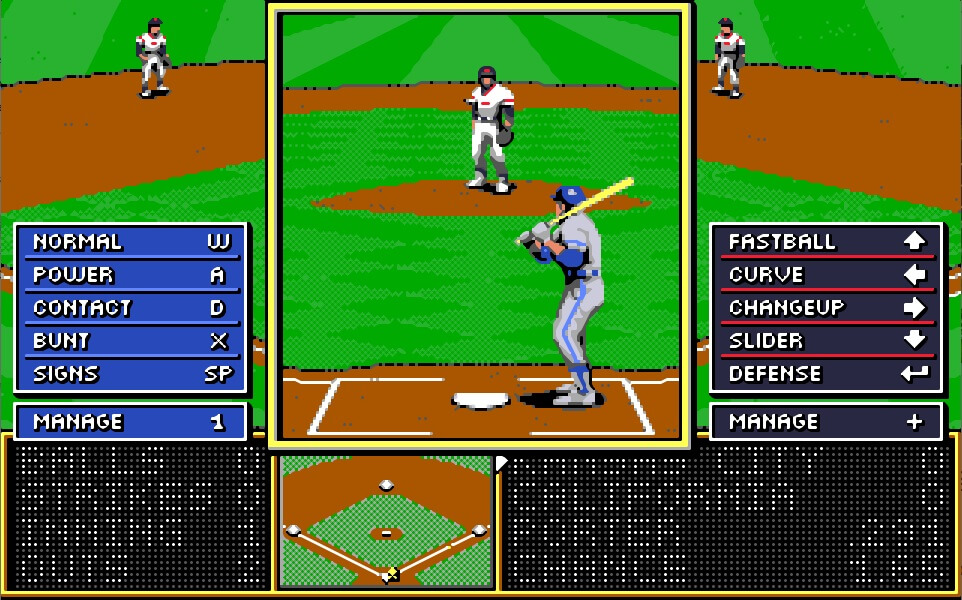
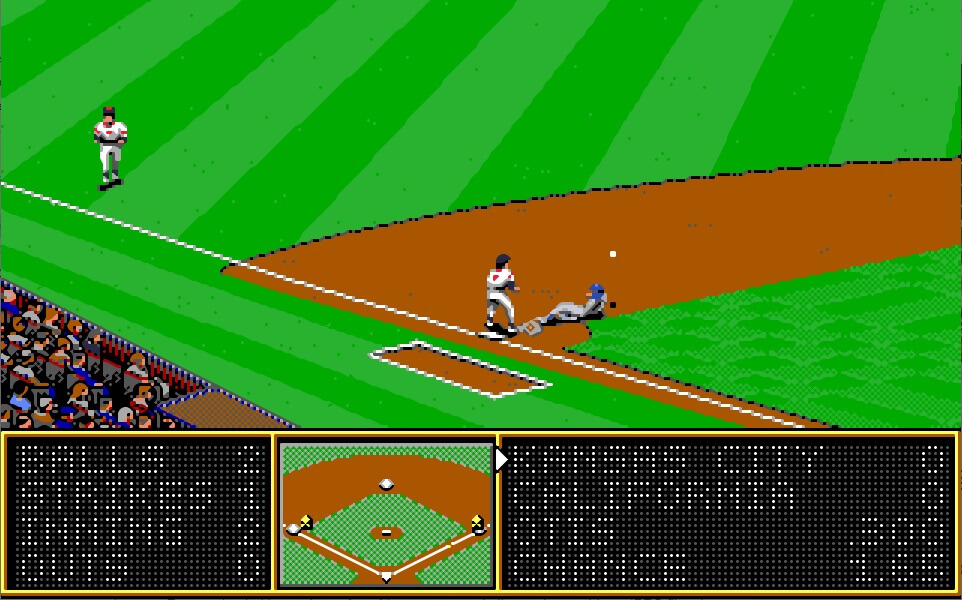
Publisher – Strategic Simulations Inc.
Release Year – 1991
Platforms –Commodore 64, IBM PC
Credits
| Game Design: | Don Daglow |
| AI & Graphics Driver Design: | Michael Breen |
| Programming: | Hudson Piehl, Mark Buchignani |
| Art & Animation: | David Bunnett (C64 & IBM), Arturo Sinclair (C64) |
| Producer: | Dan Cermak |
| Game Developer: | Nicholas Beliaeff |
| Original Music: | George Alistair Sanger |
| Music Driver: | Dave Warhol |
| Statistical Input: | Katie Jack |
Review
Tony LaRussa’s Ultimate Baseball (aka TLUB) offers the authentic outcomes of a dice or text-based hardball simulation combined with meticulously drawn player and stadium graphics. The TLUB series offers an arcade mode as well but I will concentrate my appraisal on the management and stat-keeping aspects of the game. TLUB spawned four sequels (Tony LaRussa Baseball 2, 3 and 4 along with Old Time Baseball) in a 6 year period! Available in IBM PC and Commodore 64 flavors, I based this analysis on the IBM version.
I selected the League Play option and opted to simulate an entire 162-game season using the Franchise Greats rosters that are included with the game. The process displays the standings screen that is updated as each day’s schedule is completed. You have the ability to play to a specific game/date as well as straight through to the end of the regular season. The simulated regular season completed in 20 minutes with the computer AI handling all of the minutiae such as replacing injured players in each team’s lineup and pitching staff. As I scrutinized the individual and team statistics upon the conclusion of the regular season, I was impressed with the game engine’s accuracy and sense of realism. I reached out to the game’s designer, Don Daglow, to discuss the artificial intelligence and philosophy behind the creation of this innovative series:
DB: Among the games I have reviewed to date, TLUB’s ability to manage injuries, days off and roster shuffling is top-notch.
DD: Thanks! We tuned the heck out of the AI to reach that level. Toughest problem I remember was that we kept under or over-using relievers, so starters kept having too few or too many innings/decisions and it took forever to find the center. Looking back I think that in part reflected the tendency of managers in the 90’s to leave starters in too long, and Tony’s strong focus on not doing so when the machine was simulating him.
I was determined to avoid the “1981 Rick Monday” problem where a user could play a part-time player with stronger stats in place of a starter who was weaker and “game the season.” I played solitaire Cadaco All Star Baseball board games for a 96-game season of 16 teams when I was about 15 (part of over 2,500 games where I saved all the stats and box scores), so I’d thought a lot about season play! My 1971 mainframe game was the first to replicate a full season… though it took close to an hour!
DB: Did you and your team make a conscious effort to differentiate the product from Earl Weaver Baseball? For example, TLUB omits the stadium announcements and the ballpark construction features but counters with the standard/featured game for user-friendly league play along with the in-progress scoring updates. I realize ballpark construction with such detailed graphics for stadium modeling would have been a major undertaking!
DD: My big thing regarding Weaver and my friendship with Eddie (Dombrower) was that I didn’t work on a baseball game for 2 years after I left Electronic Arts. That way I would not be turning around and competing with him immediately. After the two years I felt I’d honored the friendship and could pursue a category I loved again.
As I recall, stadium construction was an expensive wish-list item that never made it into an annual update budget, let alone the original. The 1994 strike also killed the baseball market, and though I tried to fight it for a couple of years the changes in the industry and the slow recovery of baseball led us to end the series. We added several announcers and enhanced the commentary as we could afford to do so in the subsequent editions.
—
Returning the discussion to my simulated season – After leading the Majors with 111 victories, the White Sox snatched the American League pennant by defeating the Yankees 4 games to 1. In the National League, the Giants overcame a 3-0 deficit in the Championship Series to oust the Cubs in 7 games. I chose to take over the managerial reins for San Fran.
The Southsiders journeyed to the City by the Bay for Game 1 of the World Series. Eddie Cicotte accepted the starting assignment against Giants’ ace “Iron Man” Joe McGinnity. Willie Mays lined a single to center field leading off the bottom of the second. He was promptly erased on a stolen base attempt when Ray Schalk delivered a perfect throw to shortstop Luke Appling. Successive hits by Mel Ott and Frankie Frisch placed runners at the corners. “Knuckles” escaped the threat as Travis Jackson tapped a harmless grounder to Eddie Collins at second base. McGinnity drew a base on balls to start the home half of the third. Roger Bresnahan squared around to bunt and pushed the ball towards first. Cicotte pounced on it, whirled and fired to second, but McGinnity snuck in under the throw. Bill Terry dribbled a slow roller to Collins, who raced in and fired to first for one out. Willie McCovey hit a one-hopper to first baseman Zeke Bonura who tagged the bag. However, McGinnity scrambled home as the Giants took the lead. Mays beat out an infield hit, scoring Bresnahan. Collins’ acrobatic diving stop on Ott’s sizzling grounder up the middle prevented further damage. In the fifth, Cicotte had no play when Bresnahan tapped a ball 20 feet up the third base line. Carl Reynolds made a valiant attempt to catch a vicious drive of the bat of “Smiling” Bill Terry but came up short. The Giants’ first sacker coasted into second while Bresnahan raced around the bases. McGinnity began to tire in the eighth. Bonura doubled into the right-field corner to plate 2 runs for the Pale Hose. Collins reached on an error when Travis Jackson uncorked a wild throw over Terry’s head. I signaled to the ‘pen and brought in my closer, Frank Linzy. The move paid off as Carl Reynolds popped one up into foul territory where Bresnahan settled underneath it for the last out of the eighth. Linzy retired the Sox in order to clinch a 3-2 victory for Frisco in the initial match.
“Big” Ed Walsh squared off with Carl “Meal Ticket” Hubbell in the second matchup at Candlestick Park. After Zeke Bonura singled with two outs in the opening frame, Willie Mays sprinted into right-center field and lunged at the last moment to flag down a Minnie Minoso drive. Bonura opened the fourth with a ringing two-bagger into the left field corner. Johnny Mostil delivered a one-out base knock to left but Willie McCovey’s throw nailed Bonura at the dish. McCovey ripped a one hopper off the chain link fence in right field for a two-base hit to commence the bottom of the fourth. Mays walked and Ott flew out to the warning track in left. Walsh induced Freddie Lindstrom to ground into a 6-4-3 double play. “Stretch” lined a base hit up the middle to plate Roger Bresnahan with the first run of the contest in the home half of the sixth. Bill Melton doubled to left in the top of the eighth. Pinch-runner Harry Lord advanced to third on a fielder’s choice but the White Sox failed to capitalize. Carl Reynolds ill-advised squeeze bunt with two outs was fielded cleanly by Hubbell and the throw to first arrived in plenty of time. McCovey coaxed a base on balls with two down in the bottom of the eighth. The “Say Hey Kid” launched a long fly off reliever Bob Locker into the left field corner, barely clearing the wall for a 2-run jack to extend San Fran’s lead to 3-0. Travis Jackson made a leaping grab of a Minoso liner with one out in the ninth and Bonura on first. Frankie Frisch camped under Mostil’s pop fly to secure the shutout for Hubbell and both teams headed to Chi-Town with the Giants holding a 2-game advantage.
Christy Mathewson delivered his warm-up tosses in the pen as Wilbur Wood strode to the mound for the Pale Hose. Bill Terry ripped a double into the right-field corner and Willie McCovey walked after Frankie Frisch smashed a loud out to right fielder Carl Reynolds. “Wilbah” provoked Willie Mays to offer at his knuckleball, and Luke Appling started a 6-4-3 twin-killing to extinguish the rally. Frisco assumed the lead when Travis Jackson led off the third with an opposite-field double and came around on a long single to right by “Stretch”. Orlando Cepeda belted a 2-run blast into the right-center field bleachers in the top of the sixth, extending Frisco’s advantage to 3-0. “Matty” encountered some trouble in the bottom of the eighth, but Zeke Bonura grounded into a double play and Eddie Collins followed with a two-hopper to Jackson. Roger Bresnahan legged out a three-base hit to begin the visitor’s ninth and Jackson blooped a base knock into short left field to provide an insurance run. Minnie Minoso slashed a liner towards Mel Ott, who snared the ball with a magnificent diving grab in right-center field. Appling bounced to Frisch for the final out as “Big Six” completed a 7-hit shutout. The White Sox faced a possible sweep at Comiskey Park in less than 24 hours.
The ChiSox nominated Red Faber for the task of staving off elimination while San Fran’s skipper countered with Juan Marichal. With two on and two out in the bottom of the first, Travis Jackson made a valiant attempt to corral Minnie Minoso’s blooper into short left field, but the ball avoided his outstretched glove for a single. Eddie Collins trotted home and Carl Reynolds raced to third. Minoso was promptly cut down attempting to swipe second. Ray Schalk launched a 2-run moon-shot into the left field corner in the second frame to increase the White Sox lead to 3-0. Harry Lord delivered a base hit and Zeke Bonura belted an opposite-field two-bagger beyond Mel Ott’s reach, plating the fourth run for the Sox. Johnny Antonelli began warming up in the bullpen but Marichal escaped the inning when Collins popped up to first base. The Giants got on the board in the top of the third. Roger Bresnahan remained on fire as he lashed a double that bounced on the warning track and ricocheted off the left field wall. Bill Terry dribbled a worm-burner through the right side and Bresnahan dashed homeward. The floodgates opened in the home half of the inning. Bonura tripled with the sacks full, sending the “Dominican Dandy” to an early exit. Southpaw Mike F. McCormick replaced Marichal and yielded a long single as the Pale Hose reached double-digits. Orlando Cepeda swatted a big-fly into the center field bleachers in the fourth off Faber but Frisco trailed 10-2. Luke Appling and Bibb Falk ripped back-to-back run-scoring doubles in the fourth. Chicago reestablished their double-digit advantage and “Toothpick” Sam Jones entered the match. The diamond carousel continued as the Southsiders peppered the ball all over the field. When the dust settled, the scoreboard operator posted a 7-spot and Giants began to empty their bench. The Sox tacked on a run in the fifth when Bobby Thomson booted an easy grounder to third. Marquard served up a gopher ball to Reynolds with a runner on first and the Chicago faithful rejoiced as the “20” registered in the home team’s run column. San Francisco rallied against Faber to start the visitor’s eighth, loading the bases then tallying a pair of runs on consecutive hits by Frankie Frisch and Jackson. Faber forced home another run when he issued a base on balls to Ross Youngs. Despite the commanding 15-run cushion, the Sox skipper summoned Terry Forster from the bullpen. The inning concluded swiftly when Chicago turned a picturesque 3-2-3 double play. The Giants placed runners on the corners with 2 down in the ninth, but Jim Ray Hart was injured on his route to third. Forster got Bobby Thomson on a grounder to Appling and the White Sox lived to play another day as they defeated the Giants in convincing fashion, 20-5.
The fifth bout featured a rematch between Joe McGinnity and Eddie Cicotte. “Laughing” Larry Doyle clubbed a deep drive into the lower deck in right field to put San Francisco ahead 1-0 in the third. Bibb Falk and Ray Schalk helped the ChiSox assume a 2-1 lead in the bottom of the frame on a fielder’s choice and a sacrifice fly. Willie Mays scooted home when third baseman Harry Lord fired wide of second base while attempting to start a double play, then Doyle hit into a fielder’s choice to knock in another run as the Giants reclaimed the lead in the top of the fourth. Minnie Minoso demolished an “Iron Man” offering into the second deck in left-center field to knot the score at 3-all in the home half of the fourth. Frisco answered in the top of the fifth as Willie McCovey mashed a two-base hit high off the top of the fence near the right field corner and Roger Bresnahan scored all the way from first. The Pale Hose tallied a run in the bottom of the seventh when Johnny Mostil tripled into the left field corner and raced home on a slow roller to shortstop off the bat of Luke Appling. Bob James relieved Cicotte to start the ninth for the ChiSox. He allowed a two-out walk to Doyle but whiffed Frankie Frisch. Frank Linzy replaced McGinnity in the home ninth. After issuing a pair of walks with two outs, he recovered to set Appling down on a called third strike, sending the contest into extra innings. Bill Terry drilled a one-out double and scooted to third on a high chopper by McCovey. Mays lofted a 2-1 heater from James towards the right field stands. Striking just a few inches from the top of the wall, the ball dropped on to the warning track as Terry bolted home with the go-ahead run. Mel Ott followed with an opposite-field safety and the “Say Hey Kid” scurried across the dish for an insurance run. Orlando Cepeda popped up to second-sacker Eddie Collins for the final out. The Southsiders were three outs from elimination. Portsider Johnny Antonelli entered the game to face fellow lefty Bibb Falk. The left fielder lifted an easy pop fly to Bill Terry for the first out. The Sox backstop, Ray Schalk, coaxed a base on balls. The Giants’ skipper allowed Antonelli to stay in the match to pitch to Lord. Four straight pitches off the plate and the Sox were not only alive, they were threatening to send the series back to the West Coast. Antonelli exited in favor of right-hander “Toothpick” Sam Jones. With a 1-1 count, Jones caught Schalk napping and picked him off second base! Zeke Bonura still represented the tying run in the batters’ box and Lord stretched his lead off first. Jones delivered a curveball and Bonura tapped it to Frisch at shortstop who flipped the ball to Terry for the last out. The Giants congregated near the pitcher’s mound and celebrated their World Series victory!
Ratings
Graphics – [5] The center of the screen features a close-up of the batter-pitcher matchup. After the pitch is delivered, the close-up view disappears and the infield shot is revealed. The play rewinds to one second prior (presumably done to assist with fielding in arcade mode) then the camera follows the path of the ball if it travels into the outfield or beyond. A shadow (circular cursor) appears when a fly ball is hit to help the player track the flight path. The bottom third of the screen is split into 3 sections: left – the count, inning and number of outs; center – baserunners; right – the score, current batter and pitcher. The player animation is fluid and represents the progression from character-based graphics of SSI Computer Baseball to the lifelike batter-pitcher confrontations in Earl Weaver Baseball.
Sound – [2] Sound effects are fairly sparse in this edition. The bat/ball and ball/glove sound effects are credible and the umpire’s calls are a welcome addition especially on close plays. The crowd roars when a home run is hit, but the sound abruptly stops before the batter reaches second base. The lack of music and ambient crowd noise left me with the impression that we were playing baseball in an empty stadium.
Strategy – [4] The manager can call for a specific pitch with the standard choices of fastball, curve and changeup. Depending on the current hurler’s repertoire, the fourth pitch may be a slider, knuckleball, splitter, screwball, etc. Defense options include holding the baserunner(s) or playing off the bag, charging the bunt, calling for a pitchout or intentional walk. You may adjust the alignment and depth of your defenders. Each batter has the ability to swing normally, aggressively (power) or controlled (contact) as well as bunt. Play-calling with runners on base include the straight steal, double steal, squeeze, and the hit & run. You can warm up one or two pitchers at a time. Relievers will become tired if left unattended while throwing in the pen. The usual substitutions are allowed and managers are prompted when defensive adjustments are required. When facing the computer manager, you will receive a brief on-screen prompt advising which pitchers are warming up for the opposition.
Artificial Intelligence – [4] The silicon skipper handled substitutions appropriately, getting his relievers ready at the right times and employing the correct mix of strategy.
Box Score – [2] A spreadsheet with the participants’ names along with 12 batting categories appears upon the conclusion of each contest. The batters are arranged in defensive order (not their actual lineup order) and their positions are not listed, creating further confusion when substitutes are used. The pitching screen depicts the names of each hurler (in order of appearance) with 7 counting stats. Winning and losing pitchers are denoted in the lower half of the display. If a reliever earned a save, it’s logged here along with the time, attendance and location.
Rosters – [4] – The 25-man active rosters consist of 15 position players and 10 pitchers while the 5 reserves must include 3 batsmen and 2 hurlers. In reviewing the results from the simulated season, the computer General Manager made judicious use of the entire squad for each team based on injuries and other factors. The Fantasy Manager add-on disk permitted the configuration of various league / division structures, stadium assignments and facilitated drafting players onto those teams. Manager profiles can be customized for each ball club and salaries can be assigned to individuals.
Statistics – [5] – Team names, player ratings and statistics can be edited through the Utilities menu in the main program. League leaders can be sorted on the best/worst in each category with the ability to incorporate players from both leagues or limit to a specific league. You can view leaders for a single team and look at team totals. Additionally you can view splits (vs. RHP or LHP) as well as historical vs. simulated statistics. Player ratings encompass speed, power, bunt, hit & run, range, arm, clutch, streak and injury. You can designated the “fourth” pitch for every pitcher (all are capable of throwing fastballs, curveballs and changeups). The optional “Great Teams 1901-1968” disk features 26 of the finest squads from that era.
Usage/Injuries/Ejections – [4] – Players can be injured during the course of the game (based on their injury rating) and fatigue is also a factor for pitchers. The “Days Unavailable” column tracks the number of days remaining until the player is healed or fully rested. An “R” next to the number indicates that the player is fatigued and needs to rest. You are permitted to use a pitcher with the “R” designation but it comes with an increased risk of injury and/or diminished performance. To my knowledge players cannot be ejected from the game. Part-time players are subject to increased injury probability due to overuse.
Ballparks / Park Factors – [3] – The add-on AL and NL stadium disks offer accurate depictions of the ballparks that were in use during the late 80’s while the Classic Stadium package features old-time cathedrals such as Ebbets Field, Polo Grounds, Forbes Field, Shibe Park, Old Yankee Stadium, etc. Park factors are not specifically mentioned in the manual.
Commentary – [1] – Commentary is limited to the umpire’s calls such as “Out!”, “Strike Three”, “Foul Ball” and “Ball Four – take your base”.
Scale: Ratings from 1 (worst) to 5 (best)
Total Score: 34 out of 50
Observations
A rock-solid addition to the computer baseball lineage employing a game engine refined over 3 decades by Don Daglow, Tony LaRussa’s Ultimate Baseball establishes a strong foundation for the sequels that followed throughout the next half-decade. Several innovations including the fly ball cursor, flexible stat package and the ability to simulate an entire season in ten minutes boost the overall score and advance the genre into the Nineties.
Please add a comment below if you spent a significant amount of time and/or have any recollections of Tony LaRussa’s Ultimate Baseball.
Screenshots
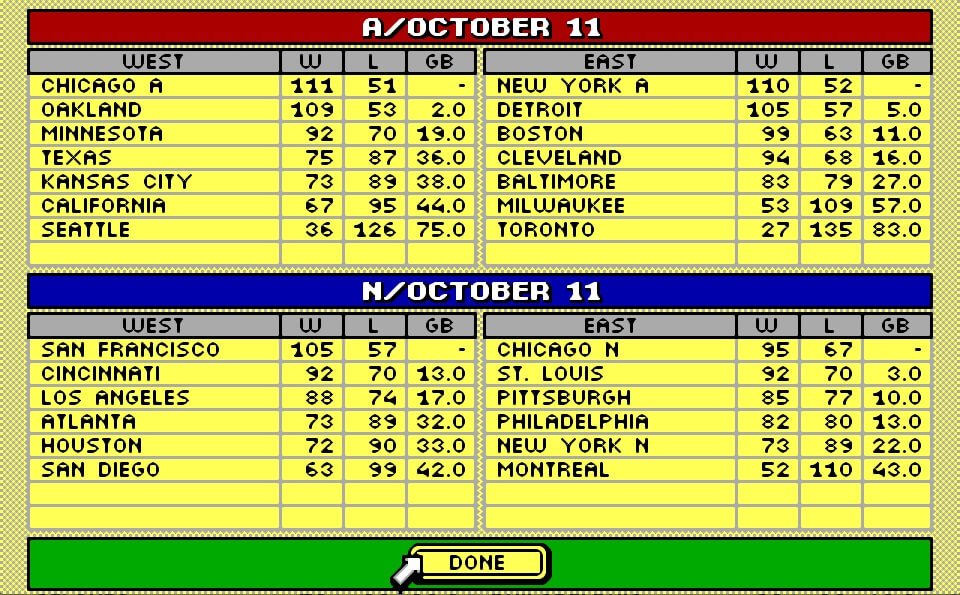
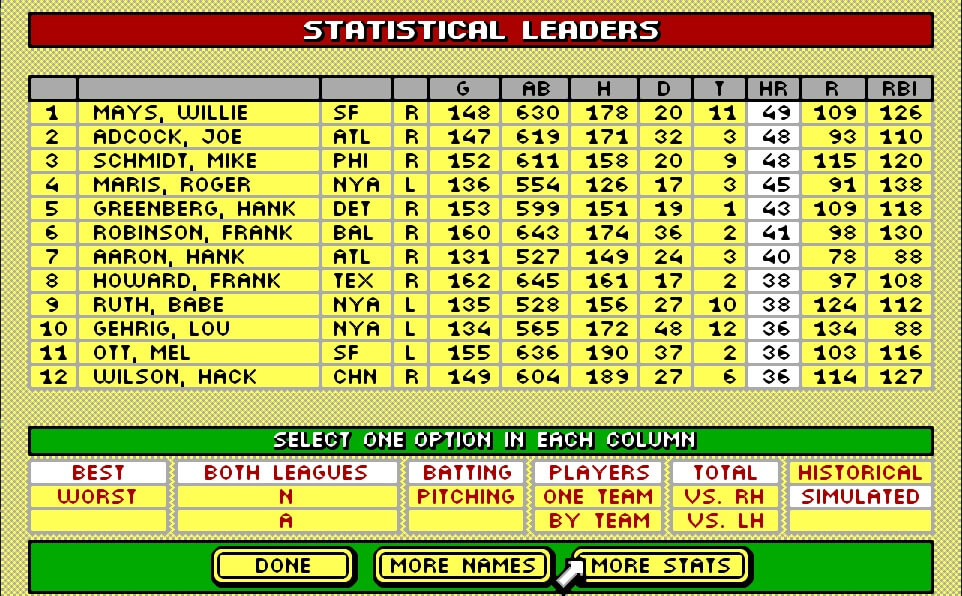
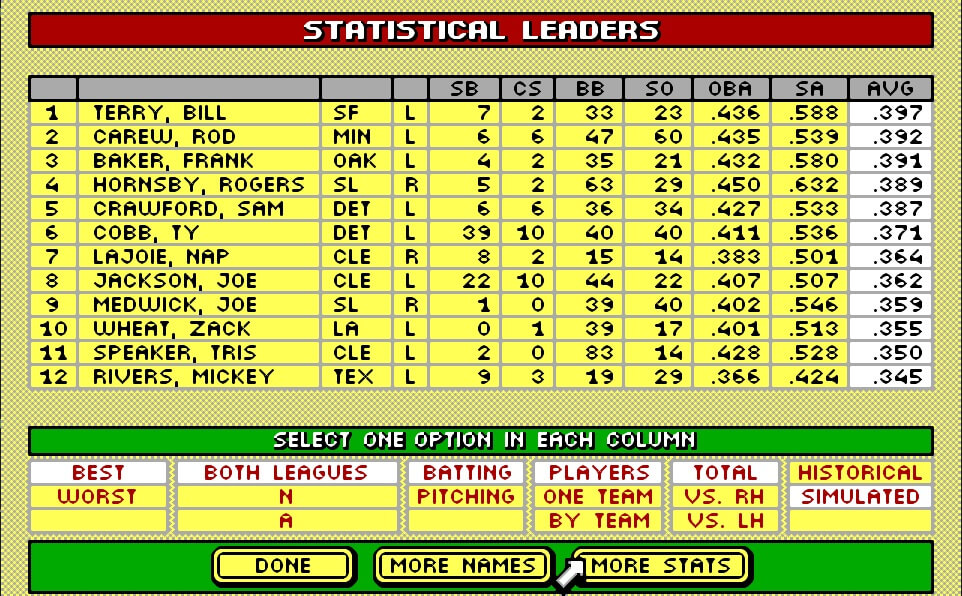
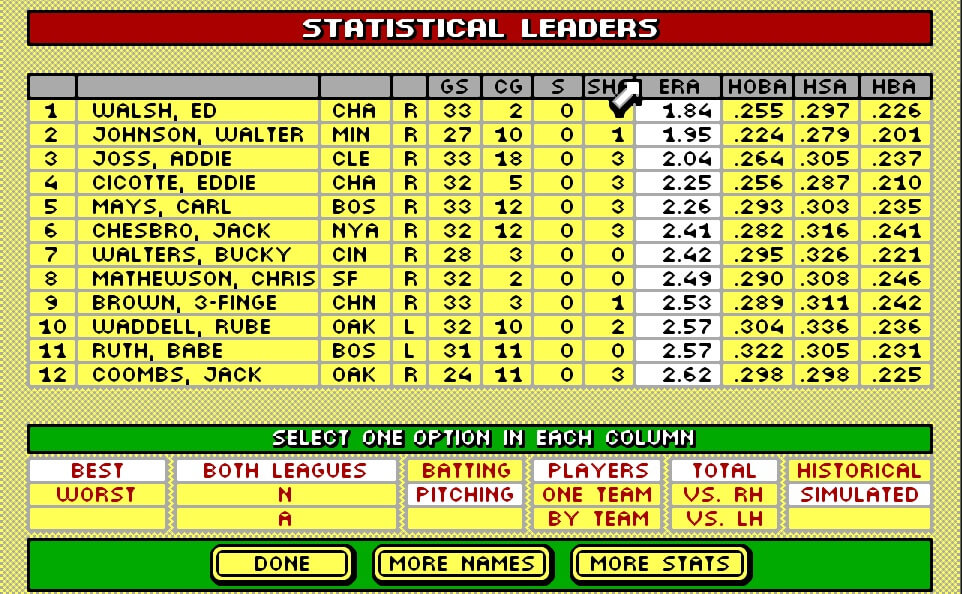
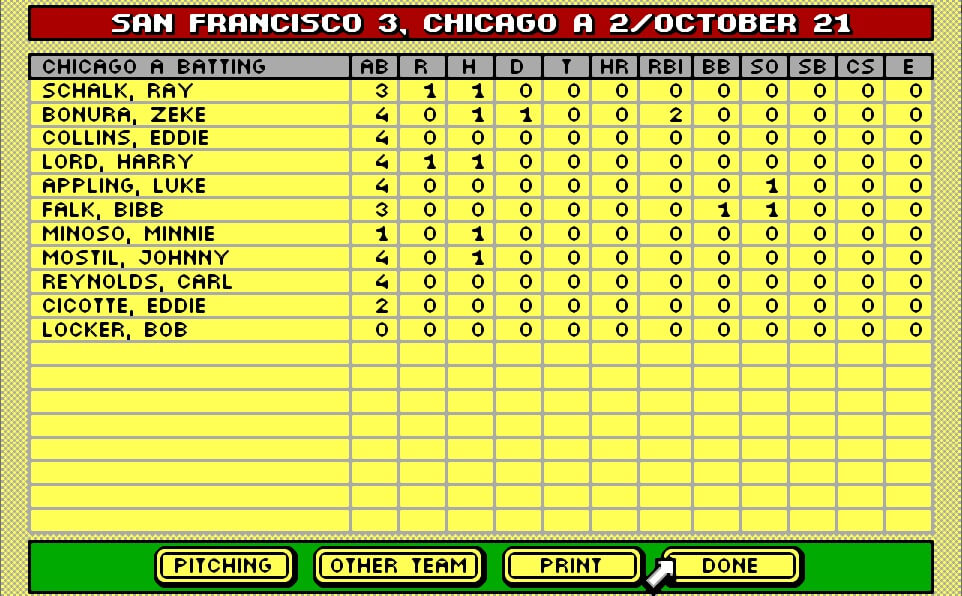
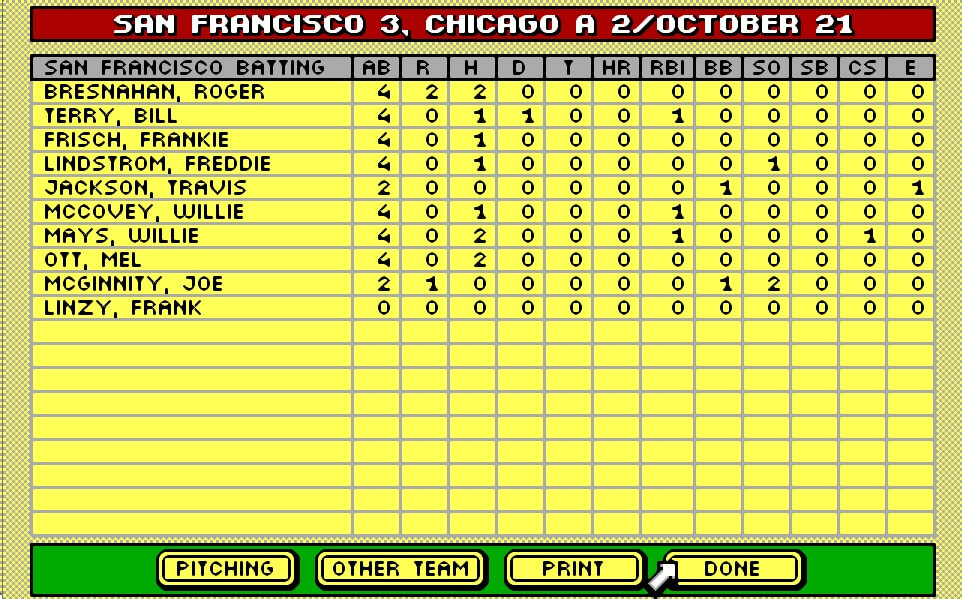
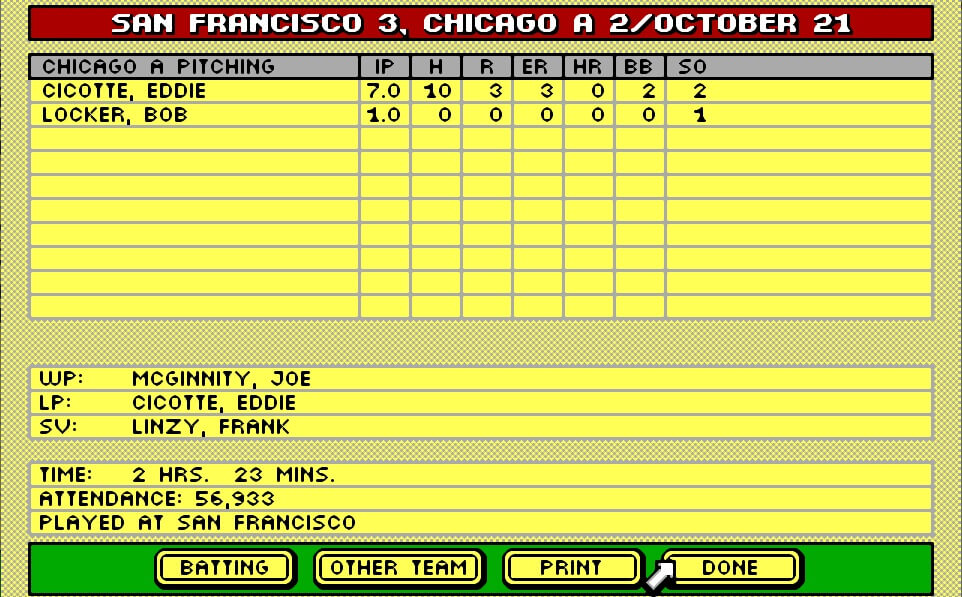
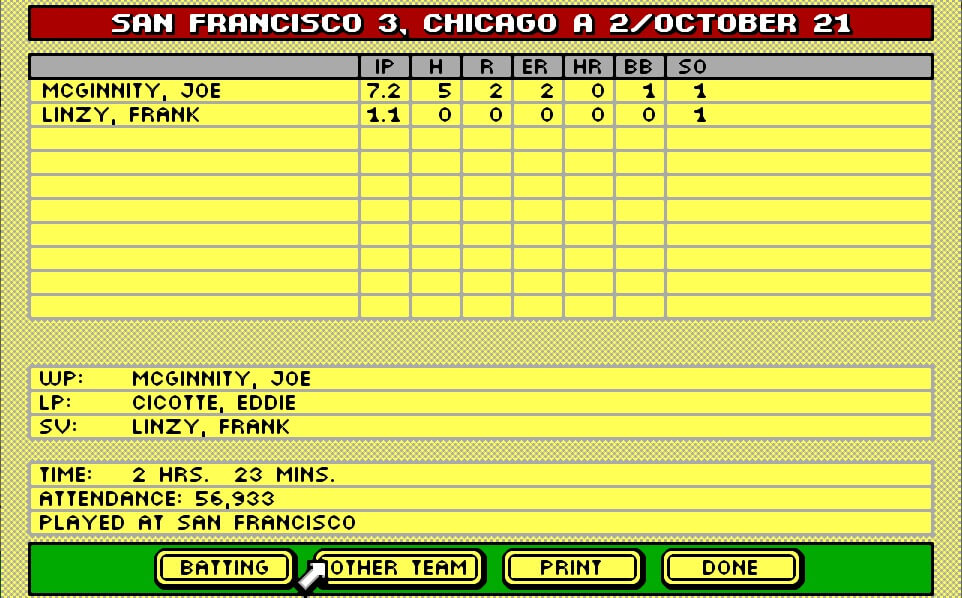
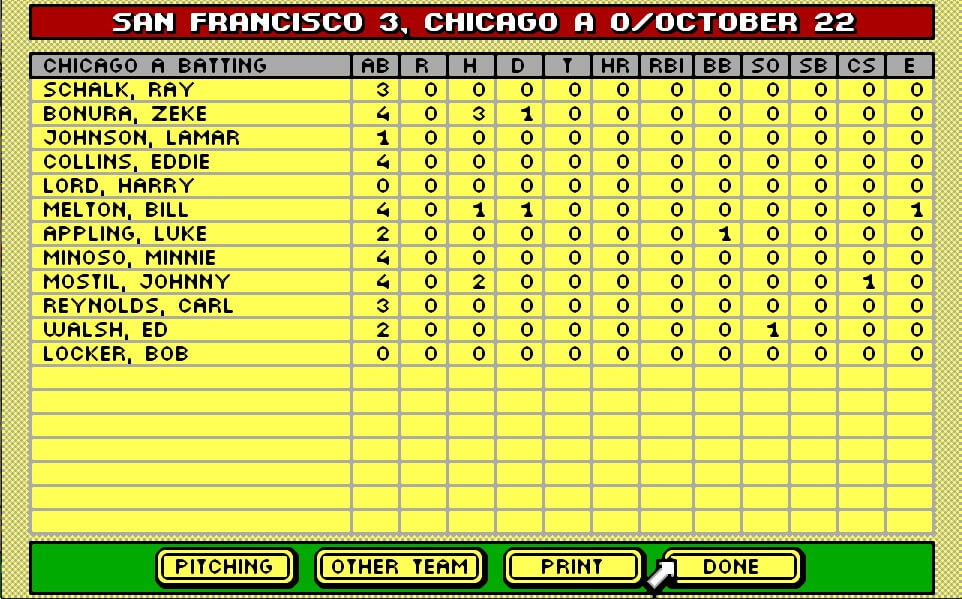
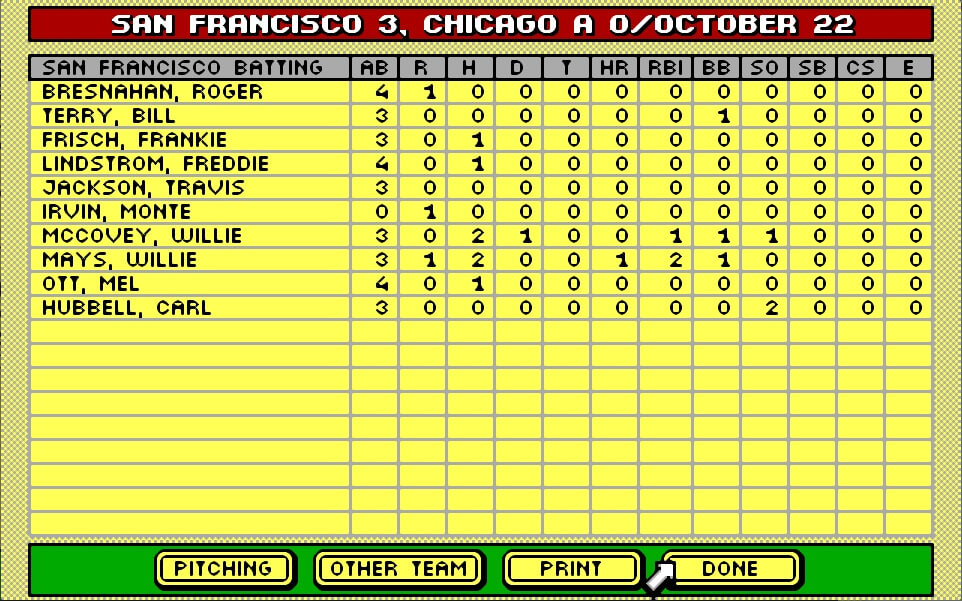
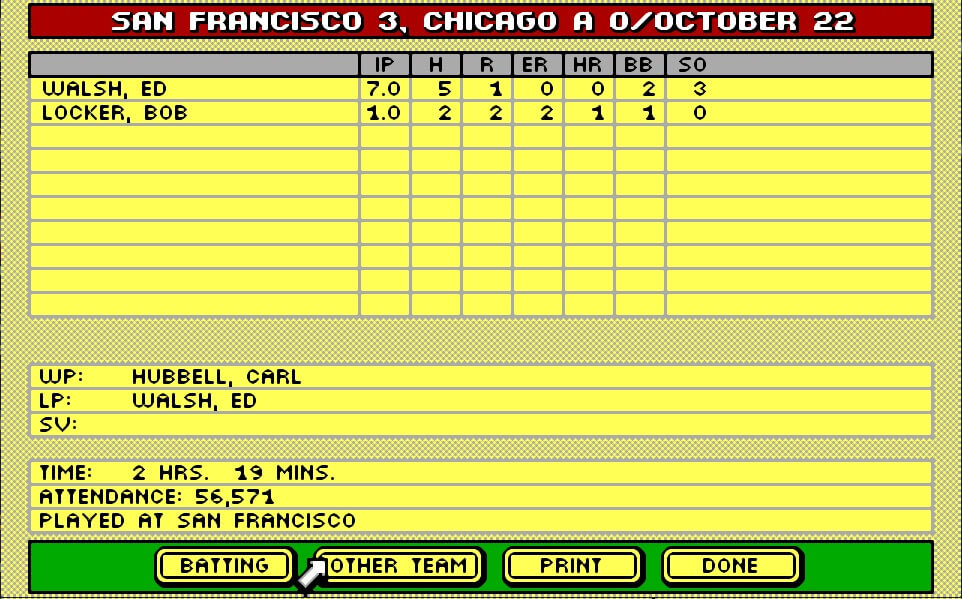
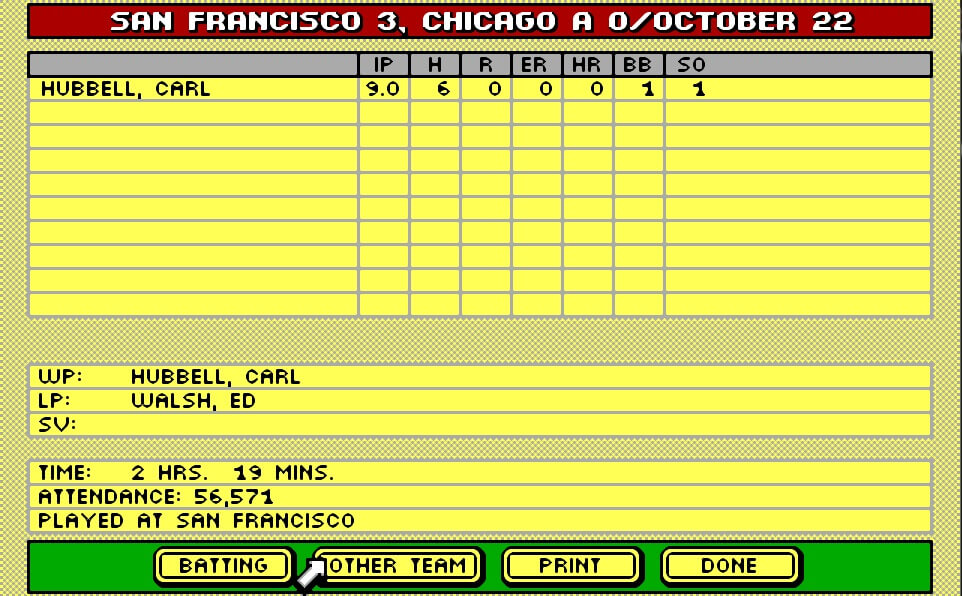
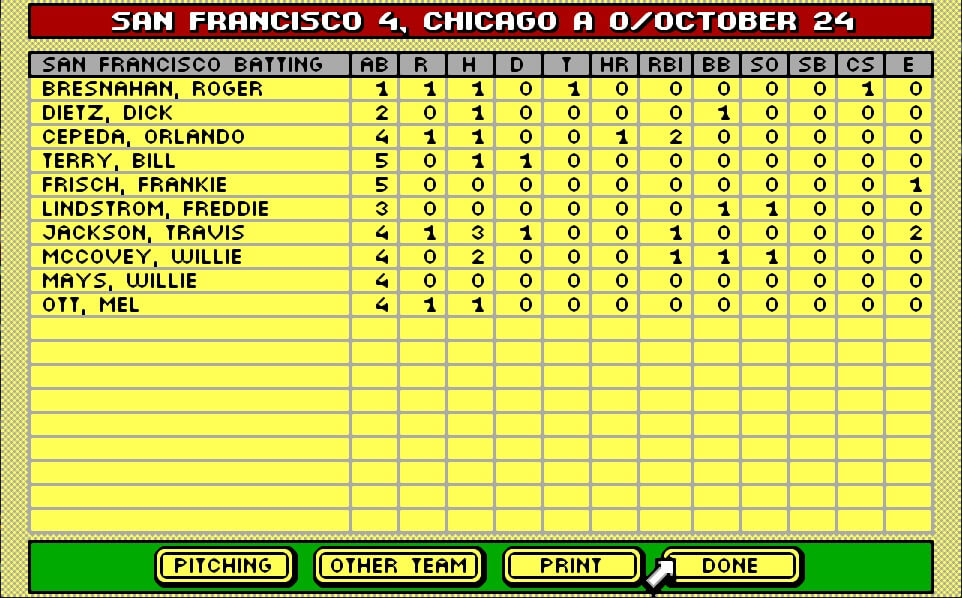
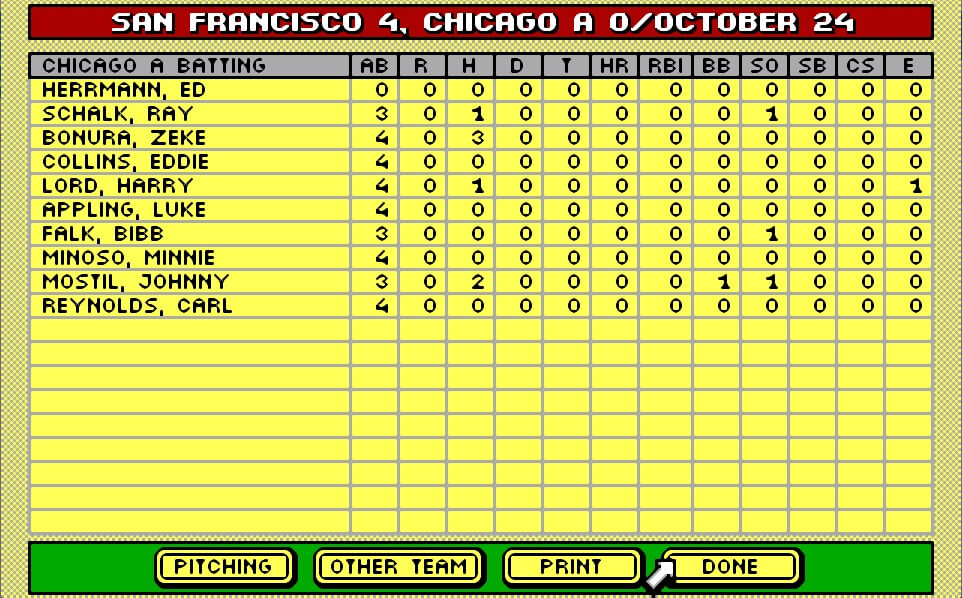
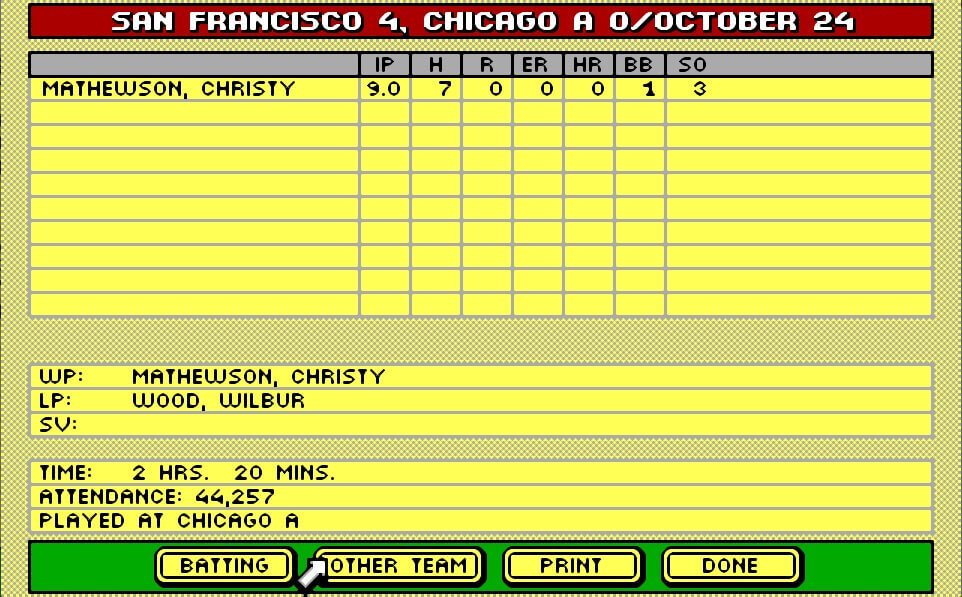
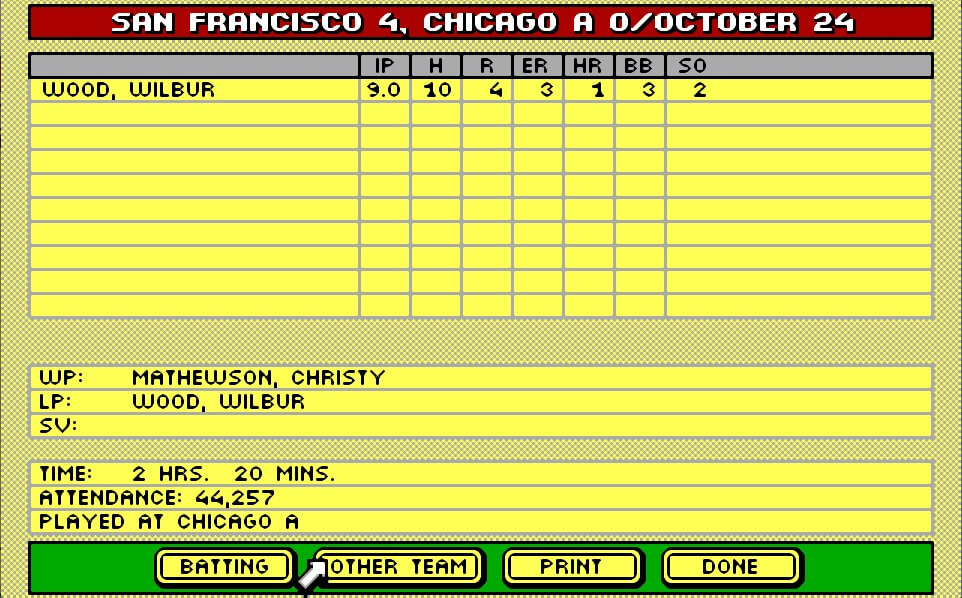
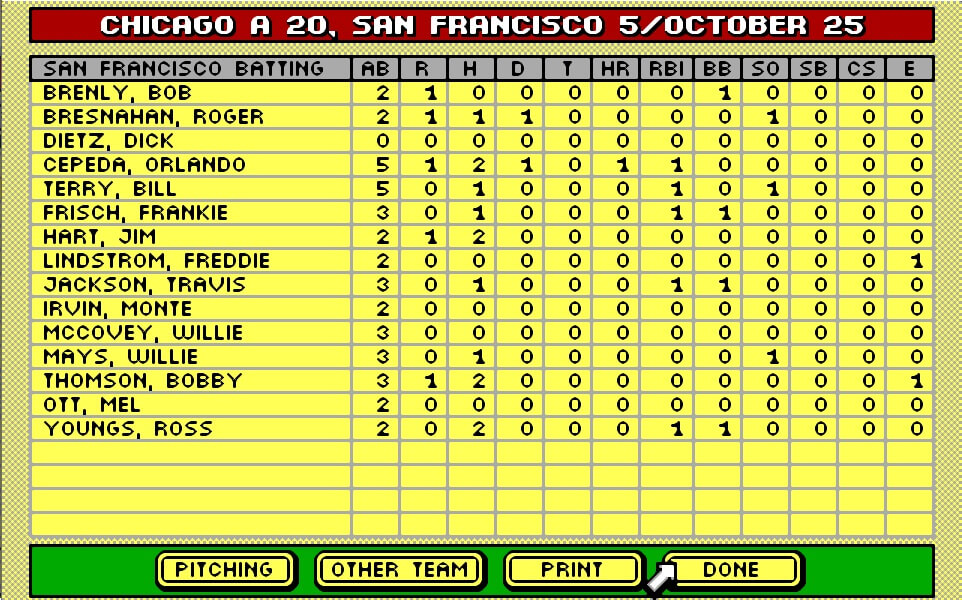
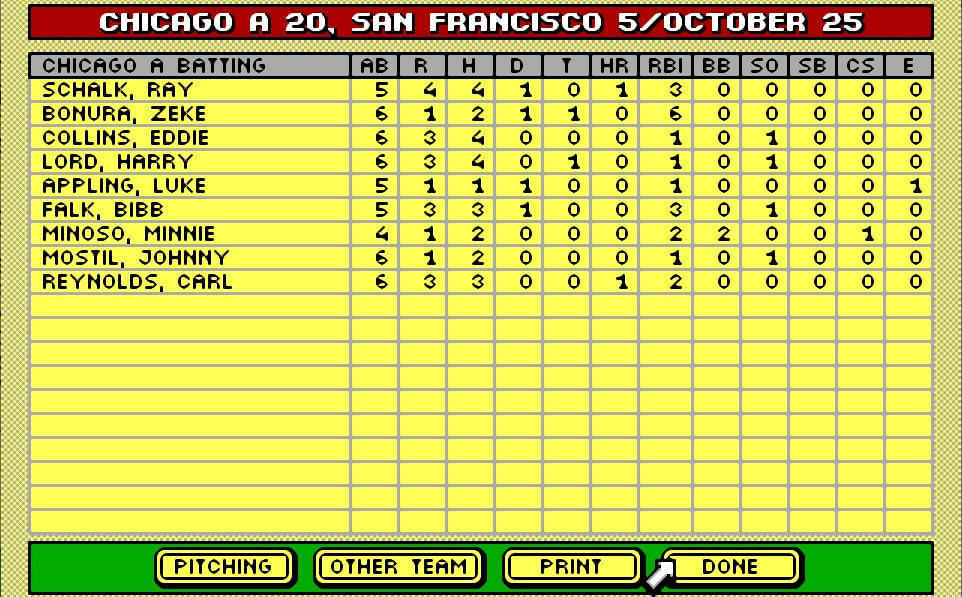
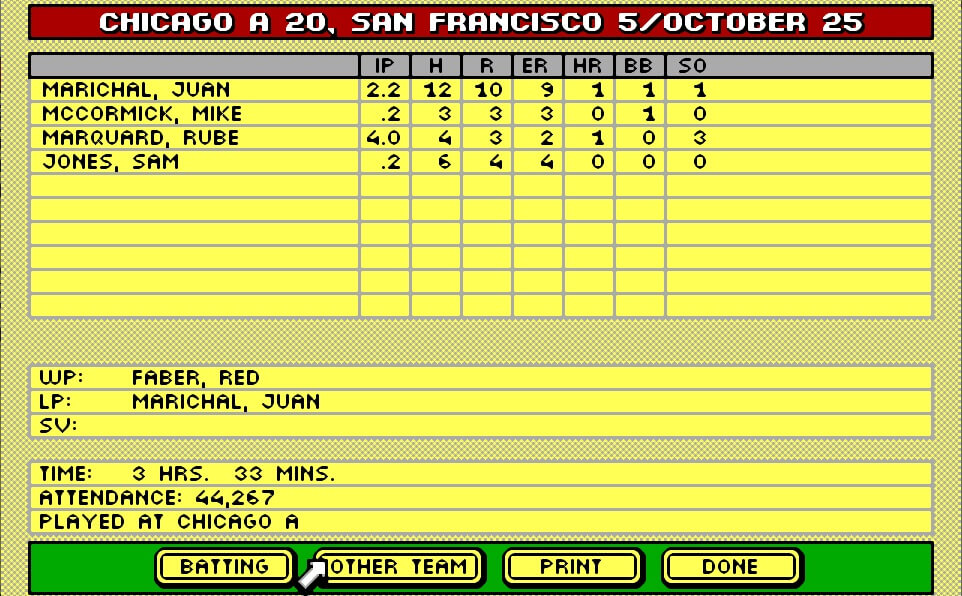
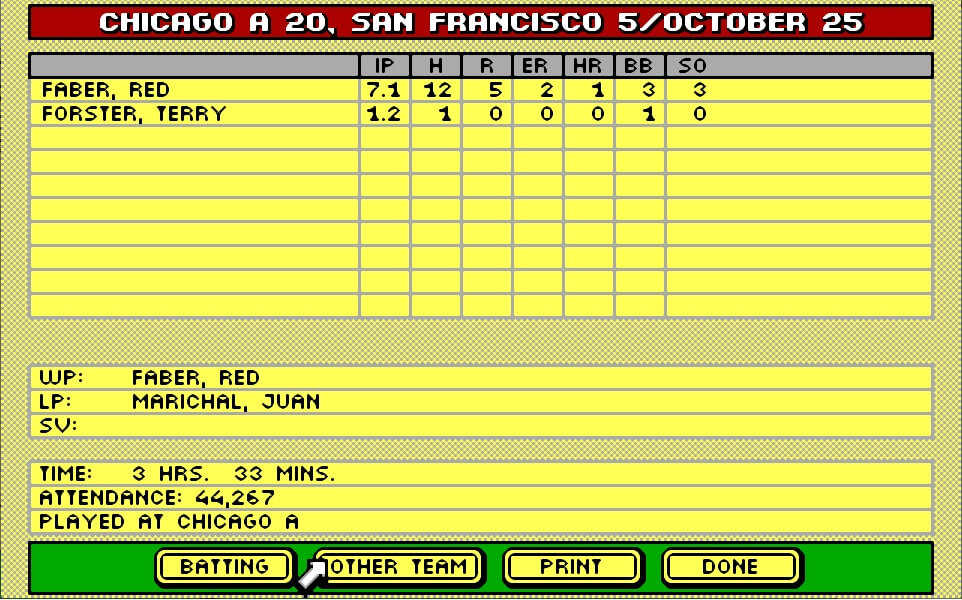

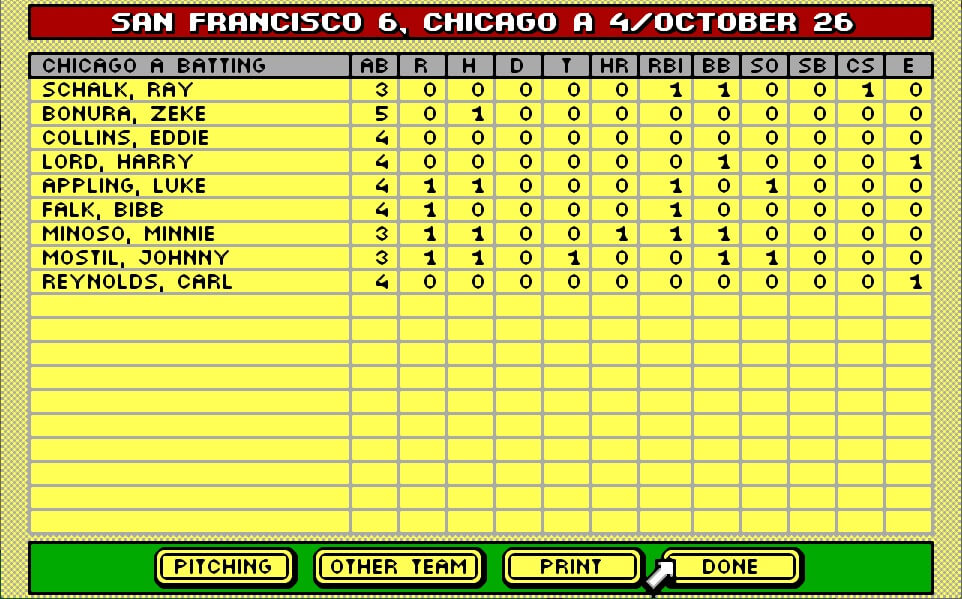
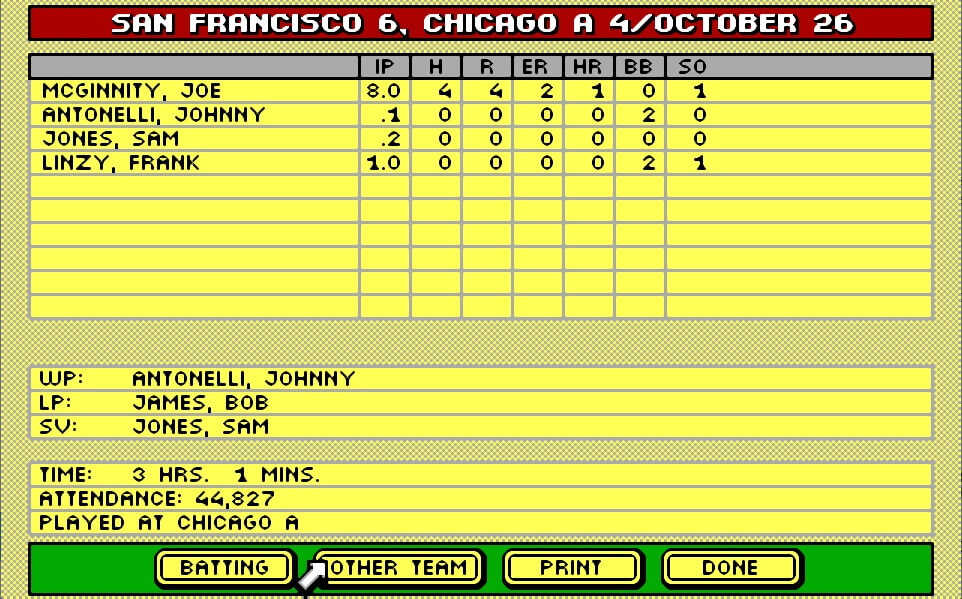
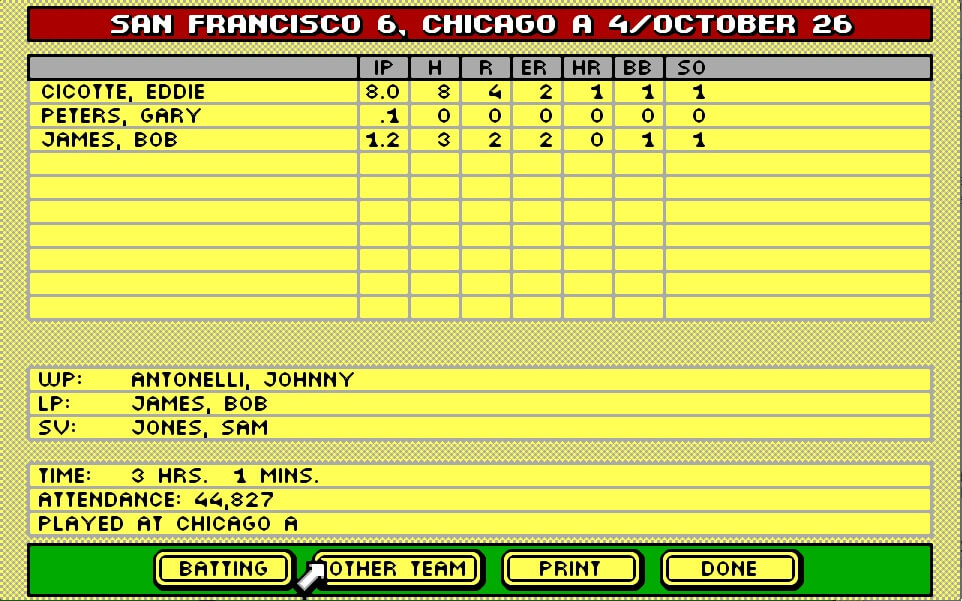
Articles in the Series
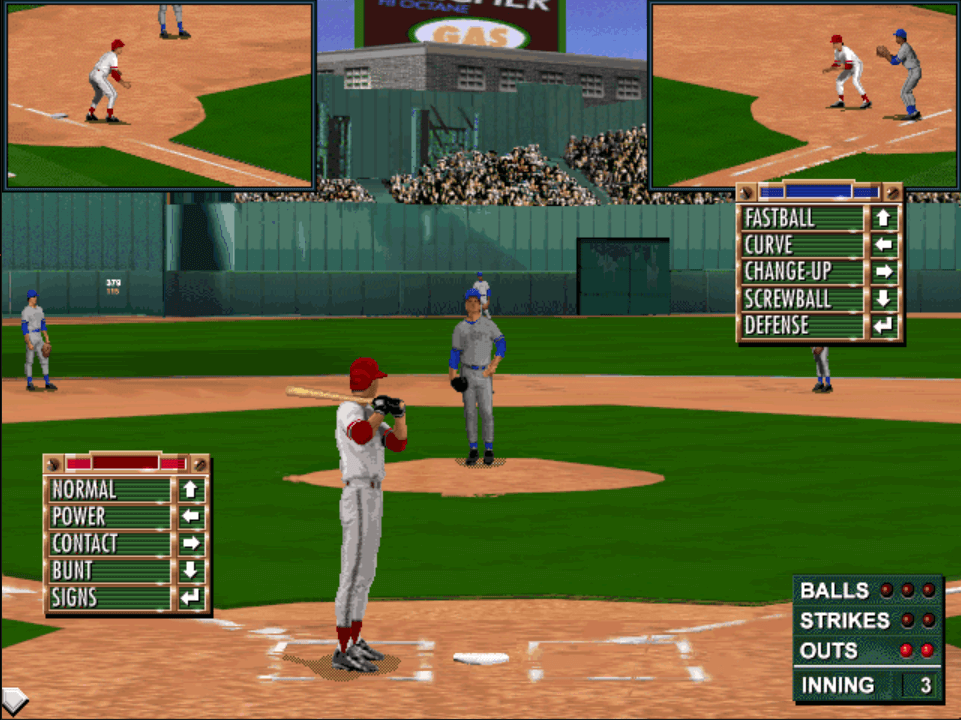 Retro Computer Baseball Game Review – Tony La Russa Baseball 3 – 4 – Old Time Baseball
Retro Computer Baseball Game Review – Tony La Russa Baseball 3 – 4 – Old Time Baseball
Additional Links
Play Tony LaRussa’s Ultimate Baseball in your browser! –
https://classicreload.com/tony-la-russas-ultimate-baseball.html#
Playthrough – HardballRetro
Murray, Rink. “386 Down the Power Alleys: Baseball Simulations Emerge From Spring Training.” PC Magazine. April 28, 1992, p493. https://books.google.com/books?id=HERlo0BgpGYC&pg=PT475&dq=pc+magazine+386+apba+baseball+simulation&hl=en&sa=X&ved=2ahUKEwiZipuBgZjoAhUCc98KHcOkDqoQ6AEwAHoECAEQAg#v=onepage&q=pc%20magazine%20386%20apba%20baseball%20simulation&f=false
Rogers, Win. “Great A’s Baseball: SSI’s Tony LaRussa’s Ultimate Baseball.” Computer Gaming World. Volume 88, November 1991, p104, 106. http://www.cgwmuseum.org/galleries/issues/cgw_88.pdf
Rogers, Win. “Not Yet the Ultimate: SSI’s Expansion Disks for Tony LaRussa’s Ultimate Baseball.” Computer Gaming World. Volume 97, August 1992, p80, 82. http://www.cgwmuseum.org/galleries/issues/cgw_97.pdf
Tony LaRussa’s Ultimate Baseball manual (IBM PC version) – https://archive.org/details/tonylarussasultimatebaseball/mode/2up
Tony LaRussa’s Ultimate Baseball manual (Commodore 64 version) – http://www.stadium64.com/manuals/tonylarussasultimatebaseball.htm
https://www.mobygames.com/game/dos/tony-la-russas-ultimate-baseball
http://www.stadium64.com/gameinfos/tonylarussasultimatebaseball/tonylarussasultimatebaseball.htm
https://www.youtube.com/watch?v=ZNjXgoVRtyU Tony LaRussa’s Ultimate Baseball, video by Squakenet
About the Author
I am a New Jersey native with a passion for baseball, statistics, computers and video games who enjoys spending quality time with his family.
“Hardball Architects – Volume 1 (American League)“, published in July 2020 and
“Hardball Architects – Volume 2 (National League)”, published in April 2022, examine the trades, free agent acquisitions, draft picks and other transactions for the 30 Major League Baseball franchises, divided into a 2-volume set. Both books are available in paperback and digital (Kindle) format at Amazon.com. All key moves are scrutinized for every team and Sabermetric principles are applied to the roster construction throughout the lifetime of the organization to encapsulate the hits and misses by front office executives. Team performances are analyzed based on transaction type with graphs depicting the WAR (Wins Above Replacement) in every decade. Individual results for each player-transaction is charted over the duration of their stint with the franchise. Every team chapter includes All-Time Rosters and Single-Season Leaders based on transaction type. The Team Trade Record chronicles the WAR and WS (Win Shares) accumulated by players acquired in comparison to those traded to opposing teams. The opening chapter is devoted to the Evolution of the General Manager and incorporates a discussion with former Dodgers GM Fred Claire (along with former Angels and Red Sox GM Mike Port and current Reds GM Nick Krall in Volume 2) on a variety of front office topics.
“Hardball Retroactive”, published in June 2018, is available in paperback and digital (Kindle) format at Amazon.com. Hardball Retroactive is a modest collection of selected articles that I have written for Seamheads.com along with my Baseball Analytics blog since 2010. Exclusive content includes the chapter on “Minors vs. Majors” which assesses every franchise’s minor league successes and failures in relation to their major league operations.
“Hardball Retrospective” is available in paperback and digital (Kindle) format at Amazon.com. Supplemental Statistics, Charts and Graphs along with a discussion forum are offered at TuataraSoftware.com. In Hardball Retrospective, I placed every ballplayer in the modern era (from 1901-present) on their original teams. Using a variety of advanced statistics and methods, I generated revised standings for each season based entirely on the performance of each team’s “original” players. I discuss every team’s “original” players and seasons at length along with organizational performance with respect to the Amateur Draft (or First-Year Player Draft), amateur free agent signings and other methods of player acquisition. Season standings, WAR and Win Shares totals for the “original” teams are compared against the real-time or “actual” team results to assess each franchise’s scouting, development and general management skills.
Don Daglow (Intellivision World Series Major League Baseball, Earl Weaver Baseball, Tony LaRussa Baseball) contributed the foreword for Hardball Retrospective. The foreword and preview of my book are accessible here.
“Hardball Retrospective – Addendum 2014 to 2016” supplements my research for Hardball Retrospective, providing retroactive standings based on Wins Above Replacement (WAR) and Win Shares (WS) for each “original” team over the past three seasons (2014-2016). Team totals from 2010 – 2013 are included for reference purposes. “Addendum” is available in paperback and digital (Kindle) format at Amazon.com.
NOTE: Original article posted on the Hardball Retro website, April 2, 2020.
A lifelong resident of central New Jersey, I enjoy spending quality time with my wife and three children. In my professional life I’ve worked for three local healthcare systems as a server and network administrator over the last 30 years. Co-chair of the SABR Games and Simulations Committee since August 2022 along with Mark Wendling.
My hobbies include baseball, statistics, computers and video games along with freshwater fishing. I have authored five books and contributed articles to Seamheads, Fangraphs and my site, Hardball Retro. Follow my HardballRetro channels on Twitch for live-streaming of classic and current baseball video games and view the resulting playthrough videos on YouTube!
Visit my Amazon author page to check out my books, promotional videos, and post a review if you're a Hardball Retro fan!
My Books:
"Hardball Retro’s Compendium of Baseball Video Games and Electronic Handhelds," published in September 2024 with co-author John Racanelli, is available in paperback and digital (Kindle) format at Amazon.com.Hardball Retro’s Compendium of Baseball Video Games and Electronic Handhelds was recognized with the 2025 Sporting News-SABR Baseball Research Award.
“Hardball Architects – Volume 1 (American League Teams)”,published in July 2020, is available in paperback and digital (Kindle) format at Amazon.com.
“Hardball Architects – Volume 2 (National League Teams)”,published in April 2022, is available in paperback and digital (Kindle) format at Amazon.com.
“Hardball Architects” examines the trades, free agent acquisitions, draft picks and other transactions for the 30 Major League Baseball franchises, divided into a 2-volume set (American League and National League). All key moves are scrutinized for every team and Sabermetric principles are applied to the roster construction throughout the lifetime of the organization to encapsulate the hits and misses by front office executives.
“Hardball Retroactive”,published in June 2018, is available in paperback and digital (Kindle) format at Amazon.com. A cross-section of essays that I penned for Seamheads.com along with my Baseball Analytics blog spanning nearly a decade touching on subjects including "Taking the Extra Base", "General Manager Scorecard", "Worst Trades", "BABIP By Location" and "Baseball Birthplaces and the Retro World Baseball Classic". Rediscover your favorite hardball arcade and simulations in "Play Retro Baseball Video Games In Your Browser" or take a deep dive into every franchise's minor league successes and failures in relation to their major league operations in "Minors vs. Majors".
“Hardball Retrospective” is available in paperback and digital (Kindle) format at Amazon.com.Supplemental Statistics, Charts and Graphs along with a discussion forum are offered at TuataraSoftware.com. In Hardball Retrospective, I placed every ballplayer in the modern era (from 1901-present) on their original teams. Using a variety of advanced statistics and methods, I generated revised standings for each season based entirely on the performance of each team’s “original” players. I discuss every team’s “original” players and seasons at length along with organizational performance with respect to the Amateur Draft (or First-Year Player Draft), amateur free agent signings and other methods of player acquisition. Season standings, WAR and Win Shares totals for the “original” teams are compared against the real-time or “actual” team results to assess each franchise’s scouting, development and general management skills.
Don Daglow (Intellivision World Series Major League Baseball, Earl Weaver Baseball, Tony LaRussa Baseball) contributed the foreword for Hardball Retrospective. The foreword and preview of my book are accessible here.
“Hardball Retrospective - Addendum 2014 to 2016”supplements my research for Hardball Retrospective, providing retroactive standings based on Wins Above Replacement (WAR) and Win Shares (WS) for each "original" team over the past three seasons (2014-2016). Team totals from 2010 - 2013 are included for reference purposes. “Addendum” is available in paperback and digital (Kindle) format at Amazon.com.
Contact me on BlueSky - @hardballretro.bsky.social
- Derek Bainhttps://sabrbaseballgaming.com/author/dbain21/
- Derek Bainhttps://sabrbaseballgaming.com/author/dbain21/
- Derek Bainhttps://sabrbaseballgaming.com/author/dbain21/
- Derek Bainhttps://sabrbaseballgaming.com/author/dbain21/
